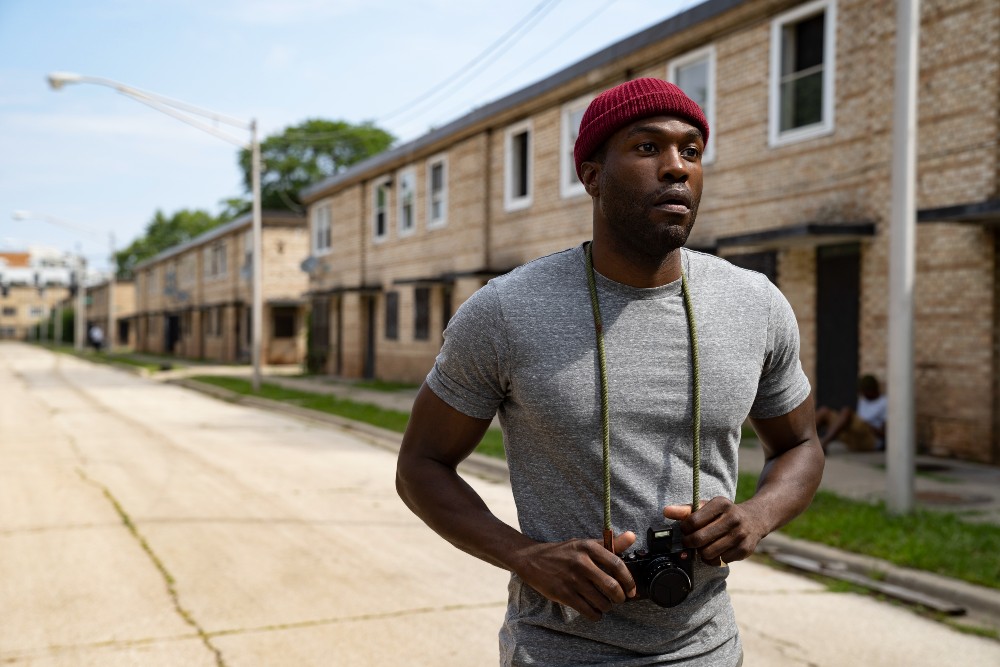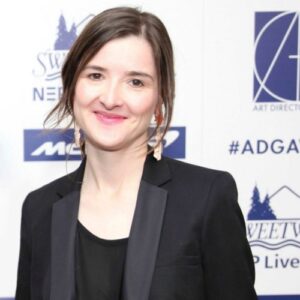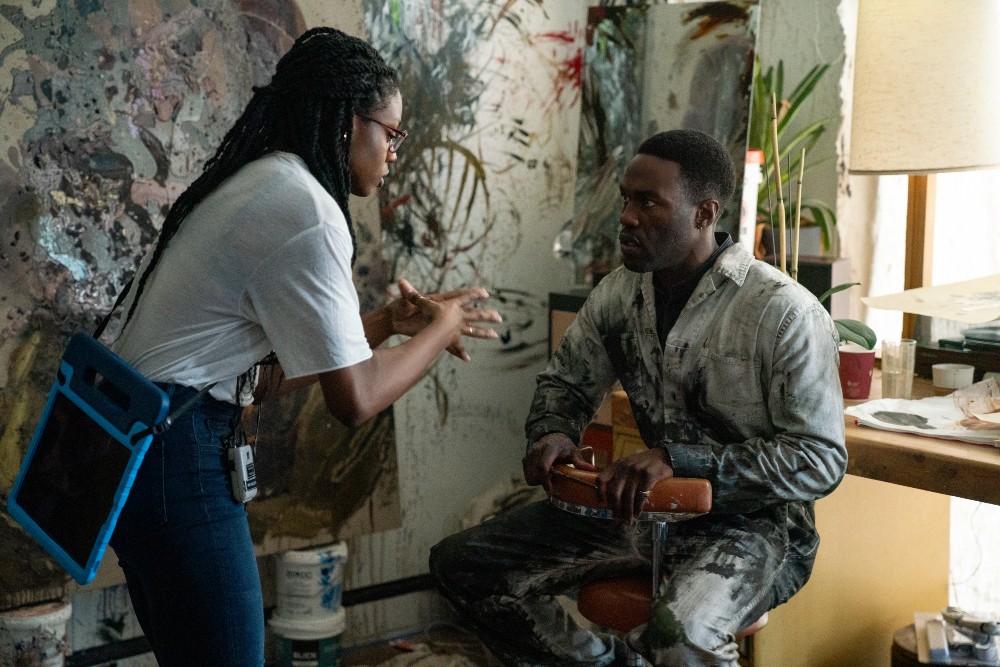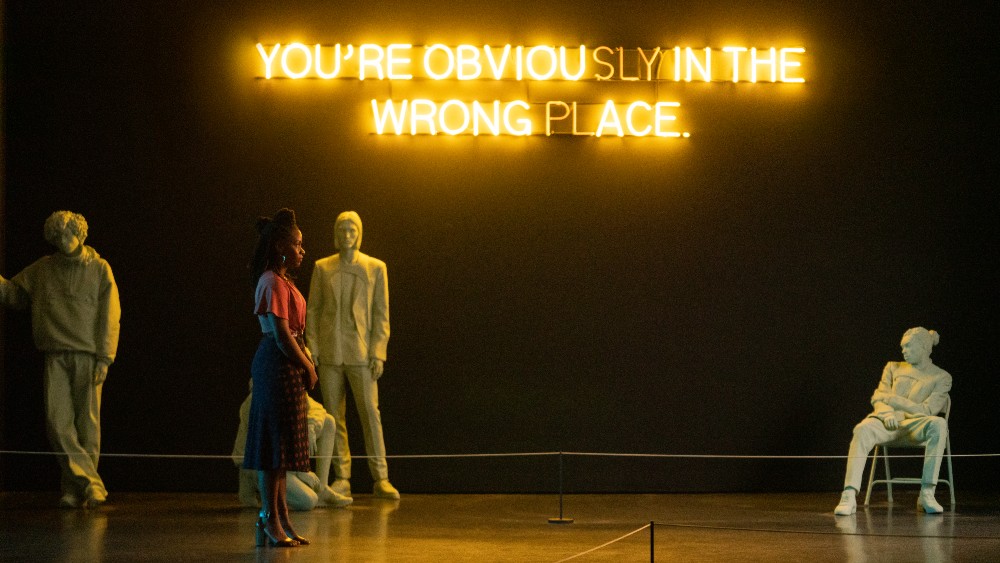
Filmmaker Nia DaCosta‘s Candyman has been out for a couple months now — and soon to come to DVD and Blu-ray, in case you missed it — but one thing that really stands out in her reinvention of the 1990 cult horror classic, and that’s the Chicago location where the film was shot. That includes all the homes and galleries we see, as well as the Cabrini-Green projects that played such a key role in the original movie.
Yahya Abdul-Mateen II (Aquaman, The Trial of the Chicago 7) plays Anthony McCoy, a Chicago-based artist who starts learning about the lore of Cabrini and its deadly protector, Candyman. As he allows those myths to permeate into his art, he starts going through a transformation that scares his art curator girlfriend Brianna (Teyonah Parris) and anyone else Anthony encounters. Also, people are starting to die whenever they say Candyman’s name five times.
Creating all of these spaces and locations came under the purview of Emmy and ADG Award-nominated Production Designer Cara Brower, who has worked on the sets of David Fincher and the Coen Brothers, but who really began making her mark as art director on David Lynch’s Twin Peaks: The Return. That led to her doing similar duties on Jordan Peele’s second film, Us, and that eventually brought her to the attention of DaCosta, who has also brought Brower over to her first foray into the Marvel Universe with next year’s The Marvels, the sequel to the 2019 blockbuster, Captain Marvel.
Candyman really gave a chance for Brower to flex her art and design muscles, especially when it comes to art, which plays such a large part in the story.
Below the Line spoke to Ms. Brower about a month back, but it seemed like this being Halloween weekend seemed the best time to share it.

Below the Line: When I rewatched the movie and focused on your work, I realized that the story is being told by where the various characters live, which is a really interesting layer to the storytelling.
Cara Brower: Oh, thanks so much. That’s exactly what I was trying to achieve with it, though. We spent a lot of time looking for all the hero locations, so I’m glad that it came across.
BTL: Even his mother’s home, which we only see for a few minutes, you can tell a lot about her compared to how he’s living with his girlfriend. I want to go back and ask about how you got into production design. Did you go to school for it or for something else and just worked your way up through the art department?
Brower: I went to grad school for production design, and I studied in England, and then I worked over there for a little bit. First worked in the art department. I just worked my way up through the art department, and then became an art director and then a supervising art director and then got involved with this film because I had art directed Us, that’s with Jordan Peele‘s company [Monkey Paw] — Jordan and his creative producer Ian [Cooper]. And then when they went to start crewing for this film, they thought that I would be a good fit. I still had to pitch and everything, so I pitched to Nia and that’s how I got the job. I originally studied production design and then up to being a designer.
BTL: What was your first meeting with Nia like? Did you put together a lookbook or anything like that? What was your pitch?
Brower: I did. I put together a lookbook, and I was on another film, and it was a very, very realistic cancer drama. I feel like when I’m on a project, I’m always just really submersed in that headspace for whatever that project is. So, I put together a lookbook. I didn’t really feel like I had nailed it, and I had a meeting with Nia. We hit it off, but then I didn’t hear anything back, and I just kept thinking about the project. “I really want to do this. I don’t think I nailed it.” So, I put together another lookbook and sent it to her again. Because after I finished the film, I fully was able to separate myself from the previous project I was on. I felt like I really nailed it that time, and so then I went in and met her at Monkey Paw with Ian Cooper. We all sat around the table and met, and we were all totally on the same page, so we really clicked as a team for that second meeting, but I really wanted to do it, so I kept going back like “Hi, have you guys hired your designer yet? Just politely saying hi again.” [Laughs]
BTL: Obviously, we still want to be careful with spoilers even though the movie’s been out for a while, but there’s a lot of twists and things to absorb. You did shoot in Chicago, and it does return to Cabrini Green, so was there anything left of the locations where they shot the first movie still around?
Brower: Yeah, that was really interesting, because Jordan and Win [Rosenfeld, co-writer] were writing the film from Los Angeles, and you kind of have to be there to really quite understand all the geography of Cabrini. The one area that they really wanted to be in the film from the beginning in the first drafts of the script — I don’t know if you’ve seen the first film too recently — but when Helen Lyle and her friend and colleague go into the Towers, they really wanted that area to be in our film. But those towers are torn down now. When I got there, and I started scouting, we knew we wanted that field to be in — it’s just a field now. The area is totally gentrified now, and it’s actually really unsettling, because there are some bits of it that haven’t been built up yet, but then, it is surrounded by lots of new luxury towers, and yoga studios and coffee shops, stuff like that. It’s kind of a strange juxtaposition, and the area where the Towers used to be, people just kind of use it as a park now. When you go there, it’s kind of a little bit anticlimactic, because you expect to see these big, towering towers, and it’s just an empty field. Once I got to Chicago, and I was exploring the neighborhood, I was kind of thinking we have to look a little outside of what was in the original film, because that’s not there anymore. So we started to look at the row houses, even though those weren’t in the original film. They’re part of what’s leftover, and we thought that could be a really powerful image of having him walk through the row houses, and then the church also, that wasn’t in the original film. But those are the two remaining pieces of architecture that are left from the old Cabrini, so we tried to figure out a way to bring them into the new story.
BTL: Were they completely abandoned or were they inhabited when you went there?
Brower: Most of them are abandoned, except for one street, which the residents were moved to that one street, and then, the rest were condemned. It’s kind of three streets of condemned housing with one street. There’s a new Arclight Cinema near there, and Nia and I went to see a movie one Friday night, and we thought, “Well, let’s drive through Cabrini,” just because we were still trying to get the lay of land. We drove down that one street where the residents are, and there was a cop car stationed on both ends of the street, and she immediately said, “We have to put this in the movie.” That line that William Burke [Colman Domingo‘s character] says, “The cops are stationed on either side of the street. We don’t know if they’re keeping us safe or they’re keeping us in,” that directly came from an experience that I had with Nia, and she wrote that [into the script] over the weekend.
In the original script, the boy Billy was supposed to have lived in one of the towers, but we would have had to build that on stage and have a completely CG exterior, but we decided, “Why don’t we just take advantage of these row houses? They’re here. You can do current day, you can do the flashback, and you can shoot 360, in and out, instead of being on a soundstage, recreating a faux-CG exterior of the towers that don’t exist anymore.”

BTL: It sounds like there’s a lot of life imitating art and vice versa in this movie.
Brower: I kind of felt like we were on a journey like Anthony, trying to discover the story as we were going along, too.
BTL: I want to get back into the looks of the different homes. Anthony and Brianna’s apartment is one of the first spaces we see, and I’d love to have a 360 camera tour to see what all the set decorators put in there, since it looks interesting.
Brower: Oh, yeah! I LOVED doing that set, and when I first got to Chicago, I read this book called High Risers, and it was the history of Cabrini. It was talking about all the people that had lived in public housing. They had been employed by all the warehouses surrounding the area, and then when the warehouse businesses moved out of the area, once it got worse and worse, they lost their earning power. Those warehouses now have been covered in the luxury lofts, so I thought it would be so interesting if they are living in one of these places that has a history to it, even though they don’t talk about that. We found a building that has a glass luxury loft built on top of this old warehouse, and it used to be a flower distribution company. It was actually huge. It was a four-floor apartment. We tried to make it look smaller, so it didn’t look as big as it did, and then we built a lot of false walls, too, so we could fill the space with art books and art. Also, when I first got to Chicago, I was trying to find the artists to paint [Anthony’s] work, and so I came across so many talented people that weren’t right for that job. But we then filled all the artwork that we had found along that journey in their apartment, so it’s all original artwork from local Chicago, and most of them black artists.
BTL: My next question was going to be about the art, because obviously, that’s a huge part of the movie between the two very different galleries and how Anthony’s own art evolves. Art is also a huge part of the storytelling. How did you go about populating the galleries?
Brower: Oh, my gosh. Well, I’ll try to tell the Reader’s Digest version, as quick as I can. I thought that was going to be the hardest part of designing the film, actually. When I first met with Nia and Ian, they asked me, “What’s the hardest part?” “Oh, my God, creating the artwork,” because I personally feel like it’s really hard to have believable artwork in films sometimes. You’re on such a fast pace, you don’t have the luxury sometimes, to find the perfect artists or the perfect art, you just have to get it done as fast as possible. Because we all wanted it to feel authentic, I just thought, “Maybe the best way to do this is to find a local artist in Chicago that has the right style, and then we work with them to develop the context.” It wasn’t scripted what he’s painting at all. So, we had to figure out what his style would be, how it changed and evolved once he becomes obsessed with the folklore of Candyman, and then, what that looks like.
I put together a lookbook of his artwork before and his artwork after. We kind of saw his work prior being somewhat trendy and tight and very controlled, but also beautiful and cool. I just wanted to make it more loose and abstract once he starts going down the rabbit hole. So anyway, when I first got to Chicago, I went to so many galleries and connected with so many artists, and just anybody that was in the art community, just getting names, looking up there art. We narrowed it down to a couple different people, and we interviewed three people. One was absolutely perfect for the work he does before, and one is absolutely perfect for the work that he does after, so we just decided, “Well, why don’t we just use both of these people? That worked out really well, and they were so great. We just set them up in a studio, and they were so excited about the opportunity and they just loved it, super- professional. Cameron [Spratley], the artist who did his early work, he’s very, very articulate as an artist, and we were able to really talk about what we wanted and show a couple of references and then he would do a lot of sketches until we were able to figure out exactly what he was painting pretty quickly. With Sherwin [Ovid], I just knew that he would be perfect for Anthony’s work afterwards, because he paints a lot of big giant faces, and they’re all so haunting and just gorgeous. We just developed this idea about him painting the faces over and over and over again. Jordan and Win had wanted to expand the story anyway to be about multiple Candymen, even though that’s a really weird term to use…. candymen. [laughs] They wanted to open up the story basically, so it wasn’t just about Tony Todd’s version of the character, so that’s how that all came about.

BTL: Were the two galleries we see in the movie real galleries that you just redressed?
Brower: No, so actually the gallery that you see, Night Driver, the one where they have the exhibition that Briana is curating, that was just an empty warehouse that we built the whole gallery in, because basically, with the time that we needed to rehearse and prep and all the stunt rigging that we were gonna have to do, and all the blood splattering we were gonna have to do — NO gallery was interested or going to be interested in giving us their beautiful space for three weeks. I really was adamant about wanting to find a gallery in the right area, which the location department was very gracious and patient with me. They showed me so many different places, but finally, we found an unused warehouse that was right in the West Loop area that was perfect. We built our own gallery there, and I went around all the galleries when I first got to Chicago, so I just used all the best ideas I thought from the different architecture and created our own space there. Hopefully, it looks real, because nobody can believe that we built that — everyone thinks we shot somewhere.
BTL: There are a lot of references to the first Candyman movie, but that gallery reminded me of a Dario Argento movie set in a gallery.
Brower: Yes! I love Dario Argento!
BTL: So there must have been some subliminal influence there, especially the glass doors.
Brower: The glass doors? Yeah, that was such a quintessential Chicago thing, too. I went to this one big beautiful gallery — the first gallery that I went to — and when I got there, they had a Theaster Gates show there, and it had the beautiful storefront glass doors. I was like, “Yes, we have to do that,” and then we went to another gallery that had the plywood furniture. We had to do that with the big plywood bookshelf, and then we worked with a curator named Hamza Walker, who is just incredible. This was Ian Cooper’s idea to work with a curator. And honestly, at first, I thought, “I can do that. I can put together the art,” but I’m so glad that we went that direction, because Hamza is just so connected and knew so many artists. We would never have had access to all these other artists that he brought in like Theaster Gates and Torkwase Dyson. He got a kick out of it, too, because he usually doesn’t curate shows with that specific of a direction. We worked with him, and Nia would say, “Okay, so let’s talk about what we want to do with this show?” We had a theme — we wanted really forward beautiful work by artists of color that Brianna had put together, but also, Nia was really specific in, “Well, I want mirrors, and I want sculptures, because I want characters to be able to hide behind them. And if we have photographs, I’d like the glass to be really reflective.” And those are never priorities for putting together an art show, but I think he got a big kick out of it, and he was totally up for the challenge. He’s like, “Great, I got it.” “We want graffiti.” “I got the person.” She wanted neon. “I got it.” It was really, really fun, and when he had fun, what he brought to the table was really fantastic.
BTL: Were you heavily involved with the shadow puppets that were used as part of the storytelling or was that another person you brought in to handle that part of it?
Brower: No, so the shadow puppet idea was already an idea that Jordan had from the beginning, but we didn’t know who was going to do it. I wanted to find somebody that could just take it on and do it with somewhat of their own style. It just so happens that there’s the shadow puppet company that I came across in Chicago. That’s all they do is shadow puppetry. They’re a theatre company, and they do some videos and things like that. They’ve never done anything to this scale, but I came across their work. I think the location manager told me “Oh, have you heard of this group, Manual Cinema?” As soon as I saw it, I thought, “Yes, this is perfect.” I went and showed Nia, and she loved it, and they were so perfect. I literally didn’t have to lift a finger, so all the credit goes for those guys.
BTL: I’m glad that things with you and Nia went so well that she brought you onto The Marvels with her, and that should be exciting fun to design a Marvel movie, and I’d love to talk to you about it when it comes out. So have they started shooting?
Brower: Yeah, we’re shooting. I’ve been working on [The Marvels] for over a year now. [laughs] We finished [Candyman] in 2019, but then we did some reshoots, right when COVID came up in 2020, so yeah, it’s been sitting there ready for everyone, and 2020…Yeah, it’s been sitting. It’s been sitting there ready for everyone for a while.
Candyman is now available On Demand and will be available on Bluray and DVD on November 16.
All photos courtesy Universal Pictures.





